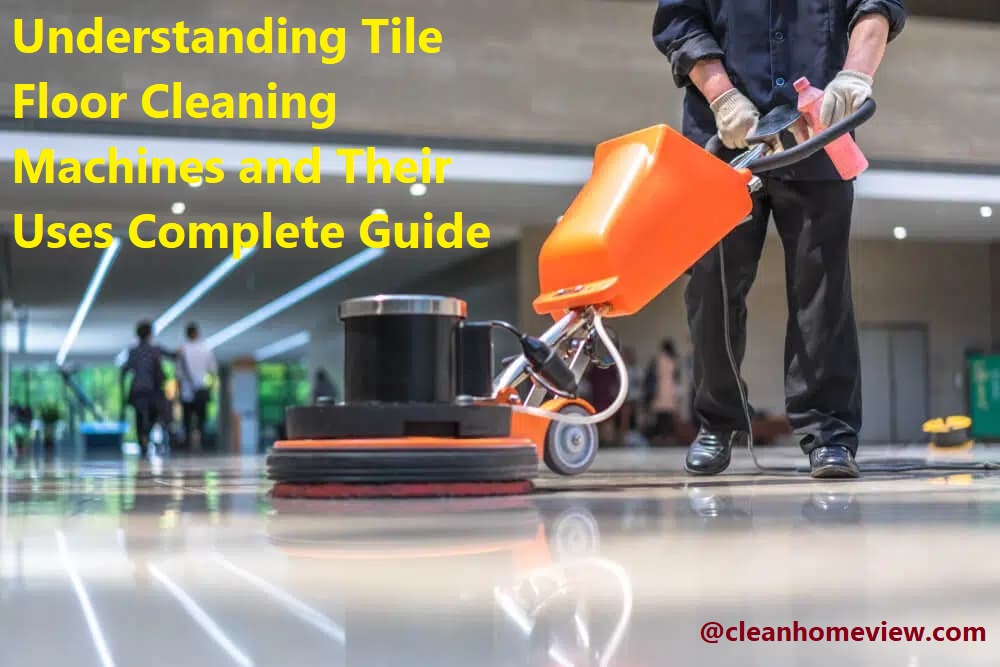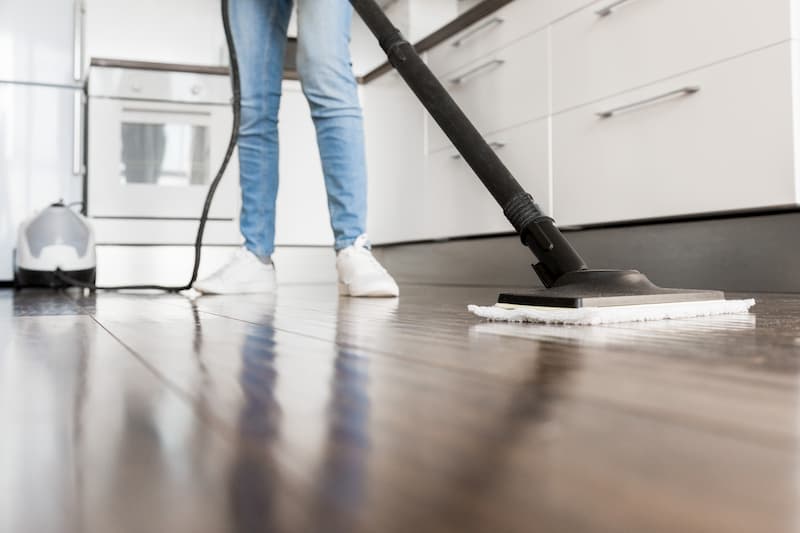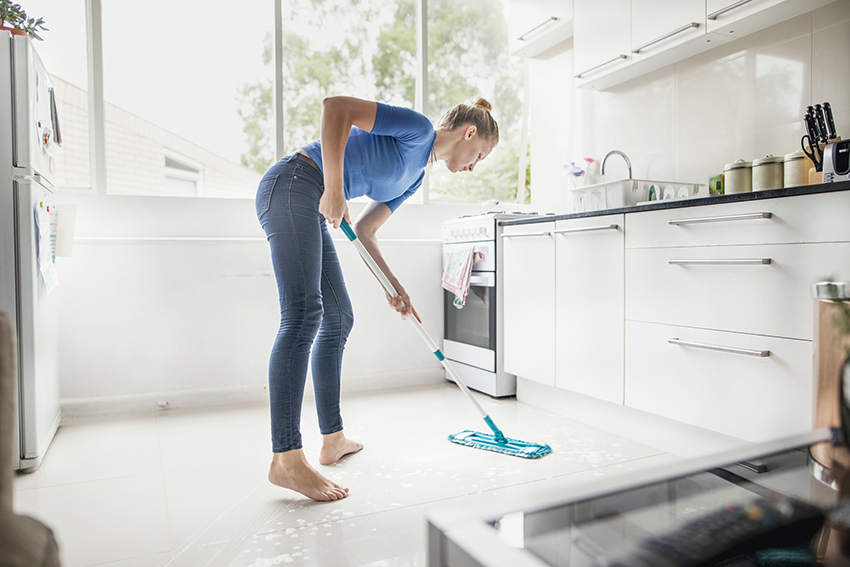Are you looking for the most efficient way to clean your tile floors? Look no further! We will help you understand tile floor cleaning machines and their various uses in this complete guide.
You’ll learn the different types of machines, why they’re essential and how to choose the right one for your needs. Get ready to make tile floor cleaning a breeze!
Tile floors can be found in many homes and other buildings, as they are an aesthetically pleasing and durable surface. However, with daily foot traffic, tile floors can become riddled with dirt and grime and may require specialized cleaning machines for efficient cleaning.
This guide will provide a comprehensive overview of various types of tile floor cleaning machines available, their features and applications. Additionally, the best practices for safe and effective tile floor cleaning will be discussed in detail. Knowing which equipment best suits your tile flooring needs is essential for keeping them clean and maintained for longterm use.
Definition of Tile Floor Cleaning Machines
Tile floor cleaning machines are a type of cleaning equipment used to clean and maintain tile floors. They are designed to remove dirt, debris, oil, grease, and other substances from tile surfaces by using foam or water pressure.
The majority of these machines provide both agitation as well as scouring with suction power that leaves the tiles looking like new. Additionally, some of the most advanced models combine chemical cleaning with scrubbing technology to achieve even better results.
These machines come in various sizes and can be used in both commercial and residential spaces.

Importance of Tile Floor Cleaning Machines
Tile floor cleaning machines are important tools for deep-cleaning hard surfaces like tile, linoleum, grout, and vinyl. They can help eliminate dirt, debris and bacteria while extending the life of your floors. These machines offer powerful suction to break down even the toughest dirt build-up on hard surfaces. They are also great for removing hard stains like oil or grease that are often difficult to remove with ordinary mops or household cleaners.
Tile floor cleaning machines come in a variety of shapes and sizes depending on your needs. Traditional canister vacuums offer a straightforward approach as they have an easy-to-maneuver handle and dedicated hose for tackling tile and other hard surface floors. Upright models also provide a great alternative as they have more powerful motors and extended reach attachments to get into those hard-to-reach areas around baseboards, cabinets and corners where dirt loves to hide. There are also several specialty machine options available such as steam cleaners (or some combination of both) for those who need an even deeper clean on their tile floors.
No matter what type of machine you choose, regular cleaning is essential for extending the life of your tile flooring by preventing buildup of soil and preventing scratches or damage caused by leftover dirt particles. The proper usage and maintenance of your machine can help protect your investment by ensuring years of enjoyment from your shiny floors.
How to Choose the Right Tile Floor Cleaning Machine
Before making a purchase decision, it is important to consider the specific use of the machine and its features. There are several key factors when selecting a tile floor cleaning machine, not just its cleaning power.
Cleaning Power: The cleaning power of a tile floor cleaner can vary depending on the type of device and its motor size. Turbine motors are more powerful than an agitator motor, thus delivering better cleaning results.
Cleaning Area: It is essential to select a machine that can clean an adequate area. Some machines have extension hoses which offer excellent coverage for larger area tasks, while others may need to be manually moved from one area to another in order to clean the entire tile surface.
Functionality: Many tile floor machines come with multiple modes and settings for different needs—from gentle for grout cleansing to tougher for deep-cleaning purposes. When choosing the right machine, it is important to determine which mode will suit your specific purpose well. For example, you would not want to use a deep-cleaning mode if you only need spot-cleaning or light scrubbing.
Reusability: The best machines offer reuseable filters that can be replaced after servicing as opposed to disposable filters that must be replaced after each use/session. Reusable filters provide exceptional convenience as well as cost savings in the long run by cutting down on filter replacement costs.
Size of the Area to Be Cleaned
- Size of the Area to Be Cleaned: Before selecting a specific tile floor cleaning machine, it is important to consider the size of the area that will be cleaned. Some machines may be too large for smaller areas, while other machines may not be powerful enough for larger spaces. It is also important to consider whether the machine can reach all areas that need cleaning. Some machines are equipped with adjustable handle lengths and arm extensions, while others require more dexterous maneuvering in order to access tight or difficult-to-reach spots. When selecting a machine for a particular space, it is essential to ensure that it has proper dimensions and features for the environment in which it will be used.

Type of Flooring Material
Each type of flooring material has its own cleaning requirements. The purpose of a tile flooring machine is to provide the specialized cleaning and maintenance solutions needed for a variety of materials, such as carpet, hardwood, laminate, ceramic, linoleum and more. Below are some examples of the types of flooring that tile floor machines allow you to clean:
Carpet: Carpet fibers are often weaved tightly together and can be difficult to deep clean with most traditional cleaning solutions. Tile floor machines are specifically designed to penetrate carpets and remove dirt from deep within the fabric. These specialized tools allow you to easily clean dust and debris from carpets without damaging the fabric or leaving behind residue.
Hardwood: Hardwood floors require specific tools in order to maintain their beauty without scuffing or scratching their surfaces. Tile floor machines offer special attachments that make it easy to remove dirt or debris without causing any damage to the floor’s finish.
Laminate: Laminate floors may require special solutions in order to maintain their shine and luster over time, such as wax-based cleaners or polishing liquids. Tile floor machines can help you ensure that your laminate floors look great by providing easy access cleaners that leave no residue behind on the surface of the laminate tiles.
Ceramic: Ceramic tiles may need specialized cleaning products in order to keep them looking vibrant over time; tile floor cleaners can easily help provide this solution while also helping ensure that no dirt or debris is left behind on tiled surfaces after cleaning is complete.
Linoleum: Linoleum needs regular maintenance in order to prevent scratching and discoloration from occurring over time; tile floor cleaners have specific attachments which allow for easily removing dust and dirt without damaging this resilient type of material.
Frequency of Use
Choosing a tile floor cleaning machine often comes down to the frequency with which it will be used. Generally, a machine that is used only occasionally, such as for annual deep cleans, needs less powerful suction, shorter recovery times, and fewer scrubbing and polishing attachments. On the other hand, if this type of machine is going to be used regularly, you may want to consider a heavier-duty model with more suction power and longer recovery times.
Lightweight models are better suited for occasional jobs while more heavy-duty machines are better for commercial tasks or ongoing residential maintenance. Additionally, machines that offer both wet and dry vacuuming capabilities may be worth considering depending on the types of stains that need to be cleaned.
Benefits of Using Tile Floor Cleaning Machines
Tile floor cleaning machines offer a variety of benefits for a number of cleaning tasks. Not only do they save time and effort, but they also help ensure that the job is done correctly and completely. Some of the best reasons to consider using tile floor cleaning machines include:
-They provide deep cleaning power, often using strong suction to remove embedded dirt and residual moisture from deep within grooves and crevices in your tiled floors. With this intensive cleaning power, you can easily remove stubborn debris from the most difficult places on your floors.
-Tile floor cleaners can remove tough stains, including pet stains and mold, that are difficult or impossible to remove with traditional mop and bucket techniques.
-These machines are often equipped with brush heads that help restore the surface finish on damaged tiles―a task nearly impossible to accomplish with manual scrubbing methods.
-With their adjustable speed settings, these machines can tackle virtually any tile floor cleanliness issues you may have―from light dusting to heavy duty deep cleanings.
-Tile floor cleaners are designed with self-cleaning features which operate efficiently while consistently keeping the machine in top operating condition over time.
Efficient Cleaning
Tile floors require regular and efficient cleaning to maintain their glossy appearance and hygienic environment. For this purpose, a variety of tile floor cleaning machines to faster and more efficient cleaning are commonly used. These machines are designed for a wide range of specialized functions for cleaning dirt, dust, grime, grease, oil and other substances from tile floors with greater speed and thoroughness.
The most common type of tile floor machine is the commercial-grade or light-duty cleaner which is typically used in homes or small offices due to its moderate power features. This type of machine is extremely quiet but works rapidly by powerful suction action and agitation from rotating brushes used to dislodge dirt particles. A similar version of this machine for heavier jobs is the multi-action or mid-sized cleaner that contains extra features such as scrubbing capability and extra-long hoses that make it suitable for larger floor areas.
High powered rotary scrubber machines are designed for tougher jobs in larger commercial settings where intensive carpet care service is needed on surfaces such as ceramic tiles and hardwood floors. These heavy duty models feature more powerful motors along with special brushes that provide rotary action in a circular motion to simultaneously agitate, suction away dirt particles from carpets while simultaneously rinsing them clean with hot water dispensers. Additionally, some higher end models come equipped with a variable speed control setting so you can adjust the power levels depending on your needs.

Time-Saving
Tile floor cleaning machines are designed to make your life easier. Not only can some of them be used multiple times in one cleaning cycle, saving you time, but they can also save you from the tedious task of manual scrubbing and washing.
With these machines, you don’t have to spend hours scrubbing or sweeping floors since they can do the job in much less time. For example, a professional tile floor machine can wash, scrub and sometimes even dry your floors in as little as 10 minutes. This means that you’ll have an immaculately clean surface without spending too much time on it.
Furthermore, some machines are even equipped with steam cleaners which offer a more effective deep clean. This eliminates dirt and bacteria without the need for harsh chemical cleaners or manual scrubbing which will undoubtedly save you plenty of time in the long run.
Improved Hygiene
Cleaning floor tiles is more than just a matter of aesthetics. Keeping them clean and disinfected is essential for promoting and maintaining a healthy environment. From commercial office buildings to restaurants, health clubs, and hospitals, the superiority cleaning machines provide cannot be overstated.
The deep-cleaning action of specialized devices removes dirt and bacteria from in between tiles as well as higher reach locations that traditional devices may not be able to reach. Enhanced vacuum suction eliminates residual dirt from any surface crevices. Additionally, adjustable brush pressure ensures thorough scrubbing with minimal damage to the tile or grout finish, preventing costly repairs or replacements.
Improved hygiene greatly reduces the risk of disease-carrying bacteria spreading among occupants who walk on these spaces regularly. Specialized cleaning solutions designed specifically to remove oil, dirt, and germs allows users to clean floors with greater confidence in their results. A nice stretch follows up skilful use of such machines, yielding a glittering floor no chemical cleaner can replicate without extensive labor input, both manual and financial.
Conclusion
To conclude, the use of a tile floor cleaning machine is the most effective way to keep your tile, grout and any stone floors looking like new. It is important to find a reliable machine that is safe to use and can provide thorough cleaning with minimal effort.
In doing your research compare industry standards and acceptability in terms of safety guidelines, usage ratings and product reviews to ensure you invest in the right cleaning machine for you. Investing a bit more upfront can lead to great savings in terms of labor costs as well as preventing unnecessary repairs down the road.
With all this information, you are now equipped choose the perfect tile floor cleaner for your home or business!

FAQ’s
How do you use a tile cleaning machine?
To use a tile cleaning machine, you need to first prepare the area to be cleaned, fill the machine with water and cleaning solution, turn it on, and then slowly move the machine over the tile surface in a back-and-forth motion.
What are the floor cleaning process and explain each?
The floor cleaning process involves several steps, including sweeping or vacuuming the surface, pre-treating any stains or spots, mopping the floor with a cleaning solution, and then drying the surface to prevent slipping.
How do you clean tile floors with a machine?
To clean tile floors with a machine, you need to first remove any loose dirt or debris from the surface, fill the machine with water and cleaning solution, and then run the machine over the tiles in a back-and-forth motion.
What machine is used for cleaning tiles?
A floor scrubber or a steam cleaner is commonly used for cleaning tiles.
What is the best method to clean tile floors?
The best method to clean tile floors is to first remove any loose dirt or debris, apply a cleaning solution, and then use a floor scrubber or steam cleaner to thoroughly clean the surface.
What is the working principle of floor cleaning machine?
The working principle of a floor cleaning machine involves using rotating brushes, pads, or a stream of high-pressure water to agitate and remove dirt and stains from the surface of the floor.
What is the use of floor cleaning machine?
The use of a floor cleaning machine is to efficiently and effectively clean large floor surfaces, such as those found in commercial or industrial settings.
What are the 5 techniques in cleaning floors?
The five techniques in cleaning floors include sweeping, vacuuming, spot cleaning, mopping, and scrubbing.
What is the best floor cleaning machine?
The best floor cleaning machine depends on the specific needs of the user, but popular options include the Bissell CrossWave, the Shark Navigator Lift-Away, and the Hoover Power Scrub Elite.
What is the best machine to clean ceramic tile?
The best machine to clean ceramic tile is a steam cleaner, as it can effectively remove dirt and grime without the need for harsh chemicals that may damage the surface of the tiles.
See Also :
- Best dog poop trash can
- Best dehumidifier for garage
- Best wrinkle release spray
- Best crawl space dehumidifier
- Best cordless irons

